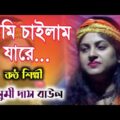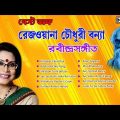বাংলা শ্যামা সংগীত | Kali Pujar Bengali Song | Top 10 Shyama Sangeet Songs | Bangla Devotional Song
০১. শ্যামা মা কি আমার কালো
০২. মা তোর চোখের কাজল সারা গায়ে
০৩. জবা কি তোর ভাগ্য রে এই
০৪. বসন পরো মা বসন পরো মা
০৫. পাগল করে দে মা তারা
০৬. আমার সাধ না মিটিল আশা না
০৭. রাঙ্গা চরণ ছুঁয়ে যেমন রাঙ্গা
০৮. বল রে জবা বল কোন সাধনায় পেলি
০৯. দোষ কারো নয় গো মা
১০. আমার চেতনা চৈতন্য করে দে মা
শ্যামা সঙ্গীত ও রামপ্রসাদী,শ্যামাসঙ্গীত,shyama sangeet,shyamasangeet,kumarsanu,bengali devotional song,ramprasadi,devotional song
#শ্যামা_সঙ্গীত #Anuradha_Paudwal #কালি_পুজোর_গান #Shyama_Sangeet_Bangla
Shyama_Sangeet #Anuradha_Paudwal_songs
#Kali_Songs #TaraMayerGan #BanglaDevotionalSongs #shyamasangeetinbengali #shyamasangeetkumarsanu #shyamasangeetin_bengali #DevotionalBenagliSongs #DevotionalOldSongs #DevotionalKaliSongs #শ্যামা_মায়ের_সেরা_গান #শ্যামা_সঙ্গীত_কুমার_সানু #শ্যামাসঙ্গীতপরীক্ষিতবালা
Shyama Sangeet
From Wikipedia, the free encyclopedia
Jump to navigation
Jump to search
Baul Song Performance – Saturday Haat – Sonajhuri – Birbhum 2014-06-28 5286.JPG
Baul Song Performing in Birbhum, West Bengal
Music of West Bengal
Genres
Classical Rock
Specific forms
Religious music
Kirtan Shreekrishna Kirtana Shyama Sangeet Ramprasadi Patua Sangeet
Ethnic music
Agamani-Vijaya Baul Bhatiali Bhawaiya Dhamail Gombhira Kavigan Bhadu Gaan Tusu Gaan Jhumur Bolan Gaan Alkap Jarigan
Traditional music
Rabindra Sangeet Nazrul Geeti Dwijendrageeti Baul Shyama Sangeet Ramprasadi Moheener Ghoraguli
Media and performance
Music media
Radio
Akashbani 106.4 FM Radio Gold Radio Mirchi
Television
DD Bangla Sangeet Bangla
Internet
http://allindiaradio.gov.in/Default.aspx
Regional music
Related areas
Bengal
Other regions
Bangladesh
vte
Part of a series on
Hinduism
1 Om.svg
Hindus History Timeline
Origins
Traditions
Deities
Concepts
Practices
Philosophical schools
Gurus, sants, philosophers
Texts
Society
Other topics
Glossary Outline
Aum Om red.svg Hinduism portal
vte
Shyama Sangeet (Bengali: শ্যামা সঙ্গীত) is a genre of Bengali devotional songs dedicated to the Hindu goddess Shyama or Kali which is a form of supreme universal mother-goddess Durga or parvati. It is also known as Shaktagiti or Durgastuti.[1]
Shyama Sangeet appeals to the common man because it is a musical representation of the relationship of eternal and sublime love and care between the mother and her child. It is free of the common rituals of worship and also the esoteric practice of the Tantra.
Contents
1 Origin
2 Divisions
3 Popularity
4 Notes
5 References
Origin
During the 12th-13th centuries when Shaktism grew in Bengal, it inspired a number of poets to compose poems on Kali. Mukundarāma, known as Kavikaṅkaṇ or ‘gem of poets, ‘ wrote his chief poem, the epic Chaṇḍī, in 1589. Towards the middle of the 18th century, the poet Ramprasad Sen instilled new life into it and turned it into a distinct genre of Bengali songs.
Ramprasad was succeeded by number of composers like Kamlakanta Bhattacharya (1772–1821), Rasikchandra Ray (1820–1893), Ramchandra Datta (1861–1899), and Nilakantha Mukhopadhyaya. In modern times both Rabindranath Tagore and Kazi Nazrul Islam have composed poems of Shyama Sangeet genre.
The term ‘Shyama’ refers to the skin color of Kali (usually depicted in black or deep blue.) Literally, it means dusky.
Divisions
Shyamasangeet can be divided into two streams: devotional or metaphysical and Durgastuti, Umasangit, Agamani or Vijaya songs. The first category of songs is inspired by devotion and spiritual thoughts. The second category which is based on themes of daily family matters or social events, is known as Padavali, Umasangit, Agamani or Vijaya songs.
Popularity
Shyama Sangeet conceptualizes Goddess Kali as a loving human mother and the singer is longing for The Mother’s love. The songs have become popular not only for its devotional side, but also for its human appeal.
The theme and occasion of Āgāmanī and Vijayā songs are as follows. Parvati (Umā or Gaurī), daughter of Himālaya and Menakā, was married to Śiva, the Lord of Kailāsa. Parvati as the form of Goddess Durga (the supreme universal mother-goddess) comes to see her parents from her in laws every year. The goddess is portrayed here as an ordinary girl living far away from her mother and feels joyous to come back home after a long stay at her in laws’ place. These songs too are highly popular because of their human appeal and as they are easily identifiable with any married girl living far away from their parents.
What Edward Thompson wrote in 1923 is true even today.
Wikipedia : https://en.wikipedia.org/wiki/Shyama_Sangeet
Thank You.
Joy Tara.






![Aami Montro Tontro By Anuradha Paudwal Shyama Sangeet Bengali [Full Song] I Maago Anandomoyee](https://bdvid.com/wp-content/uploads/2020/06/18608/aami-montro-tontro-by-anuradha-paudwal-shyama-sangeet-bengali-full-song-i-maago-anandomoyee-120x120.jpg)

